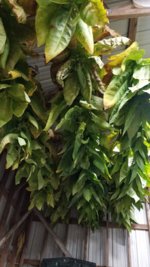albur18
Member
Hello all,
I just found this forum this year after I had gotten my first ever tobacco crop in the ground. I quickly ordered Bob's new book and found it absolutely spectacular. Most of my questions were answered eloquently in the book, and I am indebted to Bob for this wealth of knowledge, however I find myself in a situation...
I planted 28 plants this year of several varieties but because I was still trying to figure everything out from scratch, the entire process ran late and I didn't get my transplants into the ground until around June 25. This I assume is pretty late for western PA, but the plants grew well (I had worked hard to get the soil amended). They reached full height fairly quickly but by the time most of the leaves were mature so that I could stalk cut everything, it was into the very end of September. Then I got busy with a bunch of things and didnt get the plants cut and hung until around october 18! After reading and rereading the applicable sections of Bob's book, this is what I gather: it seems that when harvest timing is normal, the bigger concern is actually temperatures that are too high, which can dry out the leaves too fast and potentially dry them green. Also, ventilation is important to avoid mold. From what I understand, cooler temps arent a bad thing as they will help the leaves to dry slower, as long as the temps don't drop below freezing which if frozen, would damage the leaves. However I am so late into the autumn season that, although temps have been bouncing between lows in the 40s and highs in the 60s, I worry that the air is getting dryer as we get closer to that bone dry winter air. Could the lower humidities be hurting my late season air curing? Are the temps that I'm seeing ok for which to air cure my tobacco still? How cold is too cold? The reason I'm asking is because some of the leaf tips, as they brown, seem to get getting brittle and crinkly. Is this normal? I know mold is normally an issue but these leaves seem so dry in my current conditions that I'm wondering if I should mist them? Help! I attached a pic of when I first hung them and a pic from today. They have been hanging for about a week now.


I just found this forum this year after I had gotten my first ever tobacco crop in the ground. I quickly ordered Bob's new book and found it absolutely spectacular. Most of my questions were answered eloquently in the book, and I am indebted to Bob for this wealth of knowledge, however I find myself in a situation...
I planted 28 plants this year of several varieties but because I was still trying to figure everything out from scratch, the entire process ran late and I didn't get my transplants into the ground until around June 25. This I assume is pretty late for western PA, but the plants grew well (I had worked hard to get the soil amended). They reached full height fairly quickly but by the time most of the leaves were mature so that I could stalk cut everything, it was into the very end of September. Then I got busy with a bunch of things and didnt get the plants cut and hung until around october 18! After reading and rereading the applicable sections of Bob's book, this is what I gather: it seems that when harvest timing is normal, the bigger concern is actually temperatures that are too high, which can dry out the leaves too fast and potentially dry them green. Also, ventilation is important to avoid mold. From what I understand, cooler temps arent a bad thing as they will help the leaves to dry slower, as long as the temps don't drop below freezing which if frozen, would damage the leaves. However I am so late into the autumn season that, although temps have been bouncing between lows in the 40s and highs in the 60s, I worry that the air is getting dryer as we get closer to that bone dry winter air. Could the lower humidities be hurting my late season air curing? Are the temps that I'm seeing ok for which to air cure my tobacco still? How cold is too cold? The reason I'm asking is because some of the leaf tips, as they brown, seem to get getting brittle and crinkly. Is this normal? I know mold is normally an issue but these leaves seem so dry in my current conditions that I'm wondering if I should mist them? Help! I attached a pic of when I first hung them and a pic from today. They have been hanging for about a week now.





